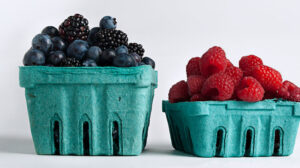Berries, delicate fruits praised for their vibrant colors and enticing flavors, require proper storage to maintain their freshness. This article aims to provide a comprehensive guide on how to keep berries fresh in the fridge.
By examining the importance of proper storage techniques, selecting suitable containers, employing effective washing and drying methods, exploring alternative options for plastic-free storage, and utilizing natural preservation methods, readers can enhance their knowledge on prolonging the shelf life of these delectable fruits.
Such understanding is vital for individuals seeking to savor berries at peak ripeness while minimizing waste.
Key Takeaways Keeping Berries Fresh in the Fridge
- Storing berries at a temperature between 32°F and 40°F slows down ripening and inhibits microbial growth.
- Using breathable containers or perforated bags prevents moisture buildup and mold formation.
- Rinsing berries with a vinegar solution (1 part vinegar, 3 parts water) significantly reduces mold spores.
- Homemade jam and freezing are natural preservation methods that help extend the freshness of berries.
The Importance of Proper Storage
Proper storage of berries in the refrigerator is essential to maintain their freshness and prevent spoilage. Temperature control plays a crucial role in preserving the quality of berries. It is recommended to store berries at a temperature between 32°F (0°C) and 40°F (4°C) to slow down the ripening process and inhibit microbial growth. This can be achieved by setting the refrigerator’s temperature appropriately or using specific compartments designed for fruit storage, if available.

In addition to temperature control, using breathable storage options can also contribute to prolonging the shelf life of berries. Breathable containers or perforated bags allow air circulation around the fruit, preventing moisture buildup that could lead to mold formation. These breathable options help maintain proper humidity levels while reducing condensation on the surface of berries.
Choosing the Right Containers
Selecting suitable containers is crucial for maintaining the quality and longevity of berries when stored in a refrigerator. Alternative packaging options can provide better protection and preserve the freshness of berries. One such option is clamshell containers, which are designed to prevent bruising and allow for proper airflow. These containers typically have small ventilation holes that help regulate humidity levels, reducing the risk of mold growth.

Additionally, choosing the right temperature is vital in ensuring optimal berry storage. Berries should be stored at temperatures between 32°F (0°C) and 40°F (4°C) to slow down ripening and extend their shelf life. Temperatures below freezing should be avoided as they can damage the texture and flavor of the berries.
Washing and Drying Techniques
To ensure cleanliness and remove any potential contaminants, it is essential to employ appropriate washing and drying techniques for berries prior to storage.

One effective method for preventing mold growth on berries is using a vinegar rinse. Research has shown that rinsing berries with a solution of 1 part vinegar and 3 parts water can significantly reduce the presence of mold spores. The acetic acid in vinegar helps kill bacteria and fungi, thereby extending the shelf life of the berries. After rinsing with the vinegar solution, it is important to thoroughly dry the berries to prevent moisture buildup, which can promote mold growth. Patting them dry gently with paper towels or using a salad spinner are effective drying methods. Following these washing and drying techniques will help maintain the freshness of your berries for longer periods.
| Technique | Steps |
|---|---|
| Vinegar Rinse | 1. Mix 1 part vinegar with 3 parts water. 2. Submerge berries in the mixture for about 5 minutes. 3. Gently swirl the berries around to ensure all surfaces are covered. 4. Rinse well under cold running water before consuming or storing them. |
Storing Berries Without Plastic
Storing berries without plastic containers offers an alternative method for preserving their quality and reducing environmental impact. Eco-friendly alternatives to plastic containers include:
- Glass Jars: Glass jars provide a non-toxic and reusable option for storing berries. They are easy to clean, do not absorb odors or flavors, and allow for better visibility of the contents.
- Stainless Steel Containers: These durable containers are lightweight, resistant to stains and corrosion, and can be used repeatedly without leaching harmful chemicals into the food.
- Silicone Bags: Reusable silicone bags offer a flexible storage solution that is free from BPA and other toxic substances found in plastics. They are also dishwasher safe and can be used in the freezer.
- Beeswax Wraps: These natural wraps made from cotton fabric coated with beeswax provide a breathable barrier that helps maintain the freshness of berries while reducing unnecessary waste.
By exploring these eco-friendly alternatives, we can reduce food waste while minimizing our reliance on single-use plastics in berry storage.
Transitioning into the subsequent section about ‘extending freshness with natural preservation methods’, it is also important to consider how certain techniques can further enhance the shelf life of berries without compromising their quality.
Extending Freshness With Natural Preservation Methods
Utilizing natural preservation methods can effectively prolong the shelf life of berries. One such method is preserving berries with homemade jam.
Berries, which are highly perishable due to their high water content and delicate texture, can be preserved by making jam at home. Homemade jam acts as a barrier against spoilage-causing microorganisms and slows down the enzymatic activity that leads to fruit deterioration. The process involves cooking the berries with sugar and acid until they reach a gel-like consistency, which helps preserve the fruit for an extended period.
Another method for extending the freshness of berries is freezing them for long-term storage. Freezing berries halts enzymatic reactions and microbial growth by reducing temperature below their optimal growth range. By properly packaging the frozen berries in airtight containers or freezer bags, they can retain their quality for several months, allowing consumers to enjoy fresh-tasting berries even when out of season or unavailable locally.
Frequently Asked Questions
Can I Store Different Types of Berries Together in the Same Container?
Storing different types of berries together in the same container may lead to faster spoilage due to varying moisture levels and ethylene production. To best store berries, use separate containers lined with paper towels to absorb excess moisture and reduce spoilage.
How Long Can I Store Berries in the Fridge Before They Go Bad?
The duration of refrigerated berry storage is influenced by various factors. Optimal storage conditions, such as temperature and humidity levels, play a crucial role in prolonging their shelf life. Implementing best practices ensures maximum freshness and minimizes spoilage.
Is It Necessary to Wash Berries Before Storing Them in the Fridge?
The necessity of rinsing berries before refrigerating them and whether unwashed berries last longer in the fridge are two key factors that warrant further investigation in order to provide a comprehensive answer.
Can I Freeze Berries to Extend Their Freshness?
Freezing berries is a common technique used to extend their freshness. This method involves placing the berries in airtight containers and storing them in the freezer. Alternatively, there are other storage methods that can also help prolong the shelf life of berries.
Are There Any Natural Methods to Prevent Mold Growth on Berries in the Fridge?
Various natural methods can be employed to prevent mold growth on berries in the fridge, thus prolonging their freshness. These methods include proper washing and drying techniques, utilizing vinegar or lemon juice solutions, and controlling humidity levels within the refrigerator.
Conclusion
In conclusion, the proper storage of berries in the fridge is crucial for maintaining their freshness and quality. By using suitable containers and employing effective washing and drying techniques, one can significantly extend the lifespan of these delicate fruits.
Additionally, opting for plastic-free storage options and exploring natural preservation methods can further enhance the longevity of berries.
In a nutshell, taking these measures will ensure that your berries remain as fresh as a daisy even after days of refrigeration.




